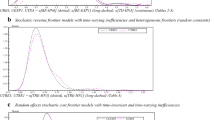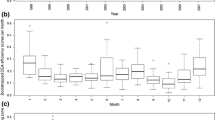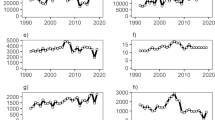Abstract
We study the impacts of individual fishing quota programs on overcapacity and the technical efficiency of the Gulf of Mexico red snapper and grouper-tilefish fisheries. We deploy generalized panel data stochastic frontier methods, which allow us to decompose time invariant heterogeneity into both vessel specific heterogeneity and persistent inefficiency. This type of decomposition has recently seen interest in a variety of applied production settings but marks the first use in fishery studies. Our main findings show that roughly 20% of red snapper fleet size could have harvested the entire red snapper quota and that the time-varying technical efficiency of the red snapper fleet grew by 6% post-IFQ. We also find that 57% of the Gulf reef fish IFQ fishery (red snapper combined with grouper-tilefish), had it operated at full efficiency, could have harvested the quota in the early stages of the IFQ program (2011–2016), and that the time-varying technical efficiency of the fleet rose by 5% post-IFQ. “The views and opinions provided or implied in this manuscript are those of the authors and do not necessarily reflect the positions or policies of NOAA”.
“The views and opinions provided or implied in this manuscript are those of the authors and do not necessarily reflect the positions or policies of NOAA”.



Similar content being viewed by others
Notes
(Solís et al. 2015a) provide an overview of empirical studies examining capacity in fisheries.
For reference, there were a total of 114,685 complete observations that reported red snapper landings regardless of fishing gear so limiting our analysis to vertical line covers roughly 82% of the trips where red snapper was caught.
Certainly this empirical practice, while common in many applied production domains, is tenuous at best, but lacking a formal selection model, the other option is to focus our attention exclusively on those landings that reported red snapper. In this case we have 63,260 trip records, roughly two-thirds of our initial sample.
This is a common issue in empirical work that typically results in researchers seeking alternative specifications to have the ability to present estimates on inefficiency. Another alternative is to use bootstrap bagging methods to construct confidence intervals for each vessel in each period.
An alternative way to think about capacity would be the use of the vessels pre- and post-IFQ. This is an interesting extension which we leave for future research.
References
Agar JJ, Strelcheck A, Diagne A (2014) The gulf of Mexico red snapper IFQ program: the first five years. Marine Res Econ 29(2):177–198
Álvarez A, Couce L, Trujillo L (2020) Does specialization affect the efficiency of small-scale fishing boats? Marine Policy 113:103796
Alvarez A, Schmidt P (2006) Is skill more important than luck in explaining fish catches? J Product Anal 26(1):15–25
Amsler C, Schmidt P (2019) Separating different individual effects in a panel data model. Econ J 22(2):173–187
Andor M, Parmeter CF (2017) Pseudolikelihood estimation of the stochastic frontier model. Appl Econ 49:5651–5661
Binh T, D’Haese M, Speelman S, D’Haese L (2010) The influence of changes in the market environment on economic production characteristics of Pangasius farming in the Mekong Delta (Vietnam). Marine Res Econ 25:293–307
Coelli TJ (1995) Estimators and hypothesis tests for a stochastic frontier function: A Monte Carlo analysis. J Product Anal 6(4):247–268
Felthoven RG (2002) Effects of the American Fisheries Act on capacity, utilization and technical efficiency. Marine Res Econ 17(3):181–205
Felthoven RG, Horrace WC, Schnier KE (2009) Estimating heterogeneous capacity and capacity utilization in a multi-species fishery. J Product Anal 32(3):173–189
Greene WH (2005) Fixed and random effects in stochastic frontier models. J Product Anal 23(1):7–32
Gulf of Mexico Fishery Management Council (2013) , Red snapper individual fishing quota program five-year review. Available from: https://gulfcouncil.org/docs/amendments/Red%20Snapper%205-year%20Review%20FINAL.pdf
Gulf of Mexico Fishery Management Council (2018) , Grouper-tilefish individual fishing quota program five-year review. Available from: http://gulfcouncil.org/wp-content/uploads/B-9a-Grouper-Tilefish-Review-March-2018.pdf
Guttormsen AG, Roll KH (2011) Technical efficiency in a heterogeneous fishery: the case of Norwegian groundfish fisheries. Marine Res Econ 26(4):293–307
Hood PB, Strelcheck AJ, Steele P (2007) A history of red snapper management in the Gulf of Mexico. In: W. F. Patterson, III, J. H. Cowan, Jr., G. R. Fitzhugh and D. L. Nieland, eds, ‘Red Snapper Ecology and Fisheries in the U.S. Gulf of Mexico’, American Fisheries Society, Bethesda, MD, pp. 267–284
Horrace WC, Schnier KE (2010) Fixed-effect estimation of highly mobile production technologies. Am J Agricult Econ 92(5):1432–1445
Huang L, Ray S, Segerson K, Walden J (2018) Impact of collective rights-based fisheries management: Evidence from the New England groundfish fishery. Marine Res Econ 33(2):177–201
Kirkley J, Paul CJM, Squires D (2004) Deterministic and stochastic capacity estimation for fishery capacity reduction. Marine Res Econ 19(3):271–294
Kirkley J, Squires D, Strand IE (1998) Characterizing managerial skill and technical efficiency in a fishery. J Product Anal 9(2):145–160
Kumbhakar SC, Lien G (2018) Yardstick regulation of electricity distribution - disentangling short-run and long-run inefficiencies. Energy J 38:17–37
Kumbhakar SC, Lien G, Hardaker JB (2014) Technical efficiency in competing panel data models: A study of Norwegian grain farming. J Product Anal 41(2):321–337
Kumbhakar SC, Parmeter CF, Zelenyuk V (2018) Stochastic frontier analysis: Foundations and advances. In: S. Ray, R. Chambers and S. C. Kumbhakar, eds, ‘Handbook of Production Economics’, Springer. Forthcoming
Mainardi S (2019) Access fees and efficiency frontiers with selectivity and latent classes: Falkland Islands fisheries. Marine Res Econ 34(2):163–195
Mainardi S (2021) Parametric and semiparametric efficiency frontiers in fishery analysis: Overview and case study on the Falkland Islands. Environ Res Econ 79(5):169–210
Olson JA, Schmidt P, Waldman DA (1980) A Monte Carlo study of estimators of stochastic frontier production functions. J Econ 13:67–82
Parmeter CF, Kumbhakar SC (2014) Efficiency Analysis: A Primer on Recent Advances. Foundations Trends Econ 7(3–4):191–385
Parmeter CF, Zelenyuk V (2019) Combining the virtues of stochastic frontier and data envelopment analysis. Oper Res 67(6):1628–1658
Pascoe S, Coglan L (2000) Implications of differences in technical efficiency of fishing boats for capacity measurement and reduction. Marine Policy 24(4):301–307
Reimer M, Abbott J, Wilen J (2017) Fisheries production: Management institutions, spatial choice, and the quest for policy invariance. Marine Res Econ 32(2):143–168
Reimer MN, Abbott JK, Haynie AC (2017) Empirical models of fisheries production: Conflating technology with incentives? Marine Res Econ 32(2):169–190
Schnier KE, Felthoven RG (2013) Production efficiency and exit in rights-based fisheries. Land Econ 89(3):538–557
SERO (2019a) Gulf of Mexico 2018 grouper-tilefish individual fishing quota annual report. Technical report, National Marine Fisheries Service
SERO (2019b) Gulf of Mexico 2018 red snapper individual fishing quota annual report. Technical report, National Marine Fisheries Service
Sharma KR, Leung P (1998) Technical efficiency of the longline fishery in Hawaii: an application of a stochastic production frontier. Marine Res Econ 13(4):259–274
Solís D, Agar JJ, del Corral J (2015) IFQs and total factor productivity changes: The case of the Gulf of Mexico red snapper fishery. Marine Policy 62:347–357
Solís D, del Corral J, Perruso L, Agar JJ (2014) Evaluating the impact of individual fishing quotas (IFQs) on the technical efficiency and composition of the US Gulf of Mexico red snapper commercial fishing fleet. Food Policy 46:74–83
Solís D, del Corral J, Perruso L, Agar JJ (2015) Individual fishing quotas and fishing capacity in the US Gulf of Mexico red snapper fishery. Australian J Agricult Res Econ 59(2):288–307
Squires D, Kirkley J (1999) Skipper skill and panel data in fishing industries. Can J Fish Aqua Sci 56(11):2011–2018
Terry J, Walden J, Kirkley J (2008) National assessment of excess harvesting capacity in federally managed commercial fisheries, Technical report, U.S. Department of Commerce. NOAA Tech. Memo. NMFS-F/SPO-93, 368
Tsionas MG, Papadogonas T (2006) Firm exit and technical inefficiency. Emp Econ 31(2):535–548
Waters JR (2001) Quota management in the commercial red snapper fishery. Marine Res Econ 16(1):65–78
Zhou J, Parmeter CF, Kumbhakar SC (2020) Nonparametric estimation of the determinants of inefficiency in the presence of firm heterogeneity. Eur J Oper Res 286:1142–1152
Author information
Authors and Affiliations
Corresponding author
Additional information
Publisher's Note
Springer Nature remains neutral with regard to jurisdictional claims in published maps and institutional affiliations.
This paper was previously circulated under the title “Fleet Capacity Dynamics in the Gulf of Mexico Red Snapper Fishery: 12 years after the IFQ”.
Rights and permissions
About this article
Cite this article
Agar, J., Horrace, W.C. & Parmeter, C.F. Overcapacity in Gulf of Mexico reef fish IFQ fisheries: 12 years after the adoption of IFQs. Environ Resource Econ 82, 483–506 (2022). https://doi.org/10.1007/s10640-022-00687-w
Accepted:
Published:
Issue Date:
DOI: https://doi.org/10.1007/s10640-022-00687-w




